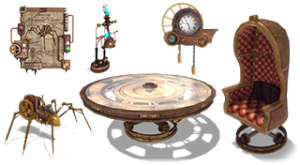Steampunk in Home
by Phoenix, HSM team writer
When it comes to interior design in Home, the rules bend towards self expression; never is that more obvious than the design choice of steampunk.
Steampunk is one of those genres that has several focal points and cultural possibilities; to begin with, steampunk is no longer the marginal fringe genre it once was. A sub-genre of science fiction and alternative history, with elements of speculative fiction placed most often in the time of the industrial revolution, it is now a part of the mainstream of world consciousness and entertainment. The main elements attributed to this movement were those made popular by authors such as Jules Verne and H.G. Wells.
Steampunk design is fantastical and chaotic in equal parts, evolving into so much more. Elements of steampunk are clockwork devices, steam trains, submarines, hot air balloons, dirigibles, high Victorian fashion items, be they English, American, or Asian, et cetera.
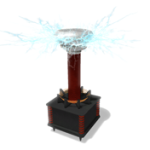 Just like fashion, interior design is all about your personal creative likes and dislikes. No matter the fashion at the time or the current trends, the individual is the main focus of any design. To start with, all you need to do is find what makes your “joy state” come alive. For me, steampunk is one of those styles. It may not be the same for you, so don’t worry if you don’t like designs created in the name of steampunk.
Just like fashion, interior design is all about your personal creative likes and dislikes. No matter the fashion at the time or the current trends, the individual is the main focus of any design. To start with, all you need to do is find what makes your “joy state” come alive. For me, steampunk is one of those styles. It may not be the same for you, so don’t worry if you don’t like designs created in the name of steampunk.
Romantic Element
For steampunk, the first element is atmosphere. Romanticism is inherent in steampunk. A look back, if you will, at elements of romance, chivalry, fine dining, definite male and female gender roles, (chivalric men and feminine — but alluringly strong — females), and all put together they possess elegance and charm. This atmosphere can be easily created in Home, using rich-colored furniture pieces, plush textures, overstuffed furniture and delicate accessories, candlesticks, candelabra (since there would be no electric lighting in steampunk), wine decanter sets, china place settings, and a few floral displays. The many elegant pieces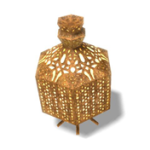 from nDreams’ Masquerade Ballrooms, and the Paris Clock Tower pieces, have that special charm to them — as well as the wedding place settings from Lockwood, just to name a few. Use these accessories around your rooms to create that feeling of romance and charm. Ample floor cushions can be found in various stores, along with Persian rugs, fireplaces, silken folding screens, inlaid folding screens and more. All can be found and had in Home.
from nDreams’ Masquerade Ballrooms, and the Paris Clock Tower pieces, have that special charm to them — as well as the wedding place settings from Lockwood, just to name a few. Use these accessories around your rooms to create that feeling of romance and charm. Ample floor cushions can be found in various stores, along with Persian rugs, fireplaces, silken folding screens, inlaid folding screens and more. All can be found and had in Home.
Material Elements
Materials used in Steampunk are all natural or mechanical, since it is before plastic and at the dawn of the industrial era. Everything would have been handmade and most often immensely decorated in great detail. The wood would have been polished and carved to show its warm inner sheen. Copper and brass would also have a polish and show some filigree work. Stained glass windows and prisms, projecting color, everywhere. In keeping with the Victorian feel or even the Wild West feel, brass pipes or something that represents steam should be present, along with some type of wheel representation; cogs and clockworks should be added. A pot-bellied stove and possible gas lamps made again of copper or brass either would reflect the warm glow of the flickering flames. Clocks, wooden and brass, were placed in every home; they were indeed a personal marvel for every man.
The Element of Technology
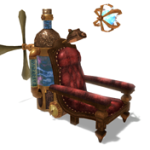 Steampunk uses inventions and innovations that were and might have been created in the era depicted. Some examples typically include clocks and clockwork creations; perhaps an alarm clock powered by steam, or a robotic dog (steam powered, of course). Nikola Tesla was a well-known engineer of the time, and a Tesla coil can be found in Home if you don’t mind the 22-slot requirement. This coil displays an arc of electricity — the beginnings of a future powered by electricity. If you want to use something similar, Juggernaut has a line of steampunk items to decorate with that are active and use less slots. These items have a Jules Verne-ish feel to them, as they hearken to the Captain Nemo theme. Some other elements that can be found and used are from nDreams again: hot-air balloons (wall items) and clocks.
Steampunk uses inventions and innovations that were and might have been created in the era depicted. Some examples typically include clocks and clockwork creations; perhaps an alarm clock powered by steam, or a robotic dog (steam powered, of course). Nikola Tesla was a well-known engineer of the time, and a Tesla coil can be found in Home if you don’t mind the 22-slot requirement. This coil displays an arc of electricity — the beginnings of a future powered by electricity. If you want to use something similar, Juggernaut has a line of steampunk items to decorate with that are active and use less slots. These items have a Jules Verne-ish feel to them, as they hearken to the Captain Nemo theme. Some other elements that can be found and used are from nDreams again: hot-air balloons (wall items) and clocks.
The Power Element
As a general rule, steampunk is pre-electric, or generates electricity via Tesla methodologies. There are several types of oil lamps to be had in Home, from Moroccan lamps in two sizes (at Sodium) to those found in the Jewel of the Skies collection. There are several Asian lanterns as well, and even a Japanese stove lamp — and many, many more. Home’s back catalogue of virtual goods is, at this point, truly staggering.
Wind and water would have been available to the populace as power sources too. Candles, of course, would have been in 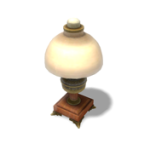 wide use, as they would have been fairly accessible and affordable to all. The use of lime-light or arc-light was in use, and is sometimes referred to as carbine. It is here, if you are using steampunk as more than décor, that you would need to invent other ways to energize your space. Wind power is a good source of energy; some personal spaces in Home have dynamic backgrounds and would be well-suited to this. The Blaster’s Paradise personal space or the Doctor Who TARDIS are both good choices for a steampunk feel.
wide use, as they would have been fairly accessible and affordable to all. The use of lime-light or arc-light was in use, and is sometimes referred to as carbine. It is here, if you are using steampunk as more than décor, that you would need to invent other ways to energize your space. Wind power is a good source of energy; some personal spaces in Home have dynamic backgrounds and would be well-suited to this. The Blaster’s Paradise personal space or the Doctor Who TARDIS are both good choices for a steampunk feel.
The long-awaited Steampunk public space, in Home, never materialized — and never will. But if you take the time to do some digging, you can easily create a variety of steampunk settings in Home that are quite remarkable. Happy decorating!
Share
| Tweet |


